Virtual exhibitions
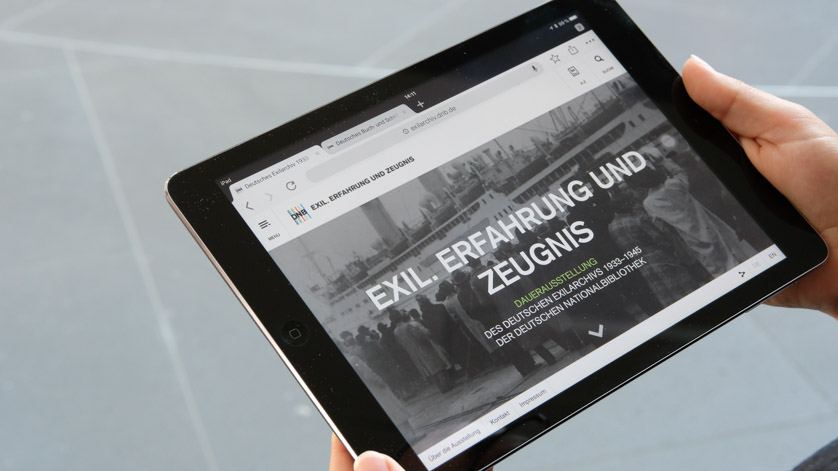
Our exhibitions in Leipzig and Frankfurt am Main are complemented by virtual exhibitions that can be accessed anywhere in the world at any time. These multimedia online exhibitions consist of a wide variety of images, videos, sound recordings and digitised original documents that keep the exhibitions accessible long after their physical counterparts have closed.
Take a journey through “5,000 years of media history online”, or visit the online exhibition “Exile. Experience and Testimony” to find out about the troubled lives of the people who had to escape from Nazi Germany. New biographies and artefacts are regularly added to the network project “Arts in Exile”.
It's well worth paying a virtual visit now and then!
100 Years First World War
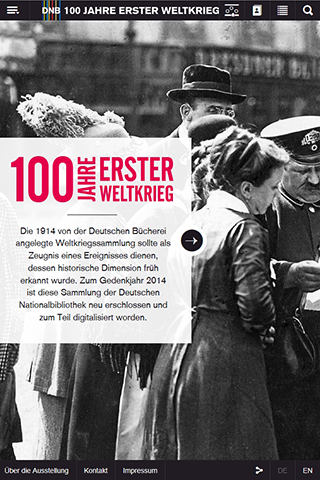
The virtual exhibition “100th anniversary of World War I” takes you back to everyday life during the war, as well as to the world of media during the time of the First World War and the November Revolution of 1918.
Over 200 different objects showcase the importance of mass media in times of war and crisis, and provide deeper insights into the areas of propaganda and censorship, among other things.
For example, you can learn about the role played by children’s and young adult literature in the propaganda machinery of World War I, or experience the deprivations of daily life during and after the war, as shown by a variety of rationing cards and posters.
The German National Library is taking this virtual exhibition as an opportunity to present items from exhibitions originally staged between 1915 and 1919.
200 Jahre Heinrich Klemm
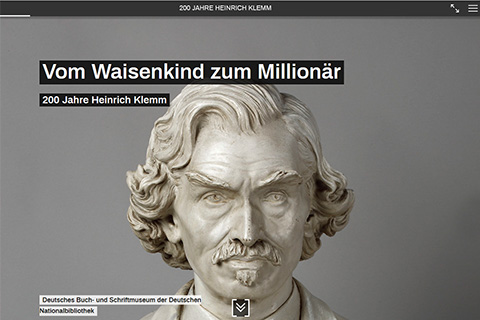
How did an orphaned apprentice tailor come by one of the world's most valuable books? 19 September 2019 was the 200th birthday of Heinrich Klemm. His collection of valuable incunabula forms the basis of the present-day German Museum of Books and Writing at the German National Library in Leipzig. This virtual exhibition explains how Heinrich Klemm came by his property and how it became one of the world’s hundred biggest collections of incunabula.
5,000 years of media history online
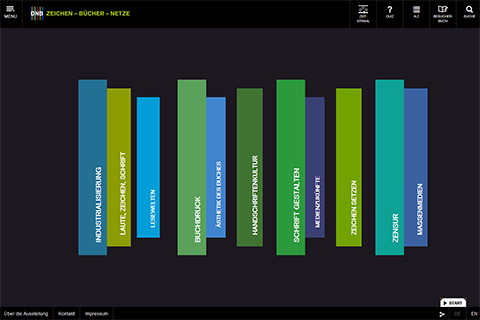
Tally sticks, Egyptian hieroglyphs, tattoos, letters, rolling book barrels, censorship lists compiled by the Catholic church, Atlantic submarine cables, Mr. Bean’s trip to a medieval manuscript reading room: the virtual exhibition “5,000 Years of Media History Online” gives you more than 1,800 greater or lesser insights into the history of media.
The exhibition includes trenchant histories, pictures, films and sound recordings related to the eleven theme modules of the permanent "Signs – Books – Networks: From Cuneiform to Binary Code" exhibition.
Go on a virtual journey through time and discover a new side to the important inventions, events and people in the history of media development. Or you can test your knowledge on “Texts and Writing”, “Book Culture” and “The Digital World” in our quiz.
A glossary restricted to the length of Twitter comments provides you with over a thousand term definitions. There is also a digital visitors’ book awaiting your questions, opinions and feedback.
Art and crisis. Klee, Kokoschka, Kollwitz & Co. save the Book Museum from closure
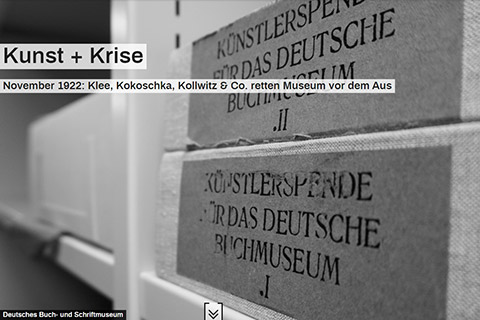
November 1922: it’s all falling apart. The heating in the offices, the lighting in the exhibitions, the salaries of the employee: everything is too expensive. The hyperinflation drove the “German Museum of Books and Writing” to ruin. What now? The last resort is to sell the museum’s most precious object: the Gutenberg Bible. But resistance emerges against this selling-out of culture. And the museum’s assistant has an ingenious idea...
The virtual exhibition presents a piece of museum history.
Arts in exile
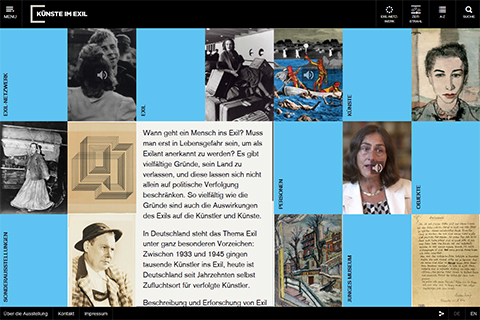
The reasons why artists leave their country are many and varied, and the effects of their experiences in exile on their work are equally diverse. The virtual exhibition “Arts in Exile” shows the many facets of exile as experienced by artists, thus making a contribution to the current culture of remembrance.
The subject of exile is especially significant in Germany: while thousands of artists were forced into exile during the Nazi era from 1933 to 1945, the Federal Republic of Germany and the German Democratic Republic became countries in which people suffering persecution after 1945 were able to seek refuge – and Germany is still seen as a place of refuge today.
“Arts in Exile” is a network project: more than 30 domestic and international research institutions, archives, museums and initiatives have contributed research findings and general content to the virtual exhibition.
Bahnriss?! Papier | Kultur
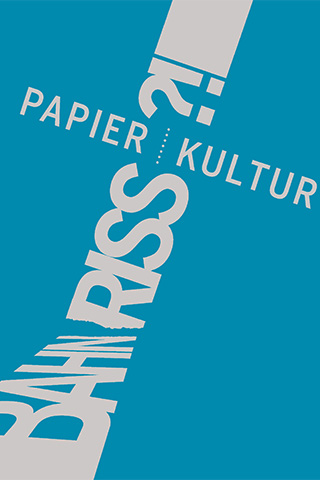
In the virtual exhibition “Bahnriss?! Papier | Kultur”, you can trace the eventful history of the “universal material” that is paper. This exhibition spans the history of paper from the rag trade of pre-industrial times via security watermarks and decommissioned newspaper printing factories to the present day. The close connection between paper and culture that has marked our civilisation for centuries is facing competition from modern media – competition that rather than heralding the decline of culture could lead to brand new solutions.
Let yourself be inspired.
The virtual exhibition “Bahnriss?! Papier | Kultur” provides permanent global access to the academic research conducted for the temporary exhibition of the same name held in the German Museum of Books and Writing at the German National Library in Leipzig in 2016.
Child emigration from Frankfurt
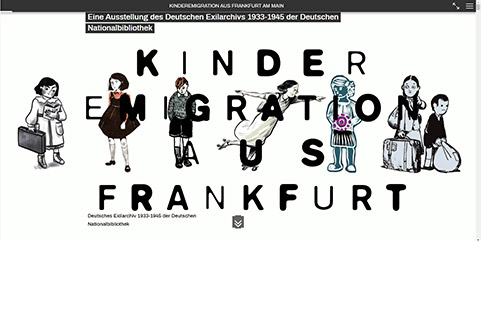 Drawings: Hamed Eshrat, Birgit Weyhe, Illi Anna Heger, Ilknur Kocer, Sascha Hommer, Magdalena Kaszuba
Drawings: Hamed Eshrat, Birgit Weyhe, Illi Anna Heger, Ilknur Kocer, Sascha Hommer, Magdalena Kaszuba
You’ll only be alone for a little while, everything will be OK – this was the hope with which parents sent their children on the so-called Kindertransporte (children’s transports). Between November 1938 and the beginning of World War II in September 1939, the Kindertransporte enabled around 20,000 children and adolescents to escape the Nazi regime. At least 600 of these children came from Frankfurt am Main.
Back home, they left behind a feeling of emptiness. Most of the children never saw their families again. Their childhood experiences marked them for life and also affected them later on when they started their own families. The virtual exhibition focuses on six children whose life stories could hardly have been more different: Lili Fürst, Renate Adler, Elisabeth Calvelli-Adorno, Josef Einhorn, Karola Ruth Siegel und Liesel Carlebach.
Due to technical revisions, the exhibition is currently unavailable.
Erika Mann. Cabaret Artist – War Correspondent – Political Speaker
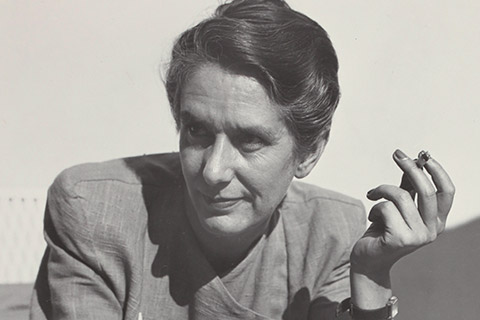 Photo: Florence Homolka, Source: Münchner Stadtbibliothek/Monacensia
Photo: Florence Homolka, Source: Münchner Stadtbibliothek/Monacensia
The exhibition “Erika Mann. Cabaret Artist – War Correspondent – Political Speaker” tells the story of Erika Mann’s (1905–1969) life and work with special attention to her steadfast championship of freedom and democracy. Numerous photographs and original sound recordings provide an opportunity to discover more about Erika Mann as a person.
With this virtual exhibition, the German Exile Archive 1933-1945 complements a temporary exhibition of the same name, which will be on show in Frankfurt am Main from 8 October 2020 to 10 July 2021. It was created by the Monacensia in the Hildebrandhaus together with the curator Prof. Dr. Irmela von der Lühe.
Exile. Experience and Testimony
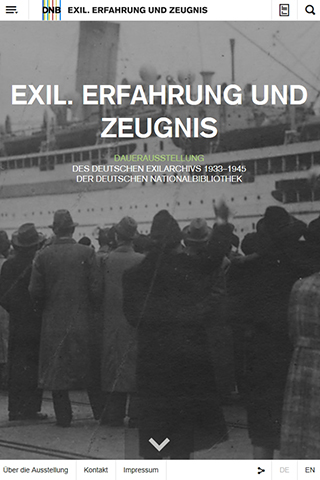
What does it mean to have to go into exile? What awaits one there? Does exile ever finish? And what remains of exile?
The online exhibition has the same structure as the permanent exhibition and, similarly, renders the biographies of eight exiles virtually accessible. These biographies are representative of countless different personal histories. Further background information is provided in the form of country profiles and a who’s who glossary.
The Epilogue focuses on the stories behind the objects themselves. What is their provenance and how did they arrive in the archive?
“Frag nach, Just ask“ – Virtual Exhibition of the digital interactive interviews with Inge Auerbacher and Kurt S. Maier
 Graphic: DNB
Graphic: DNB
The virtual exhibition features selected images, items and audio content from the “Just Ask!” exhibition that has been open to visitors at the DNB Frankfurt site since September 2023. The exhibition tells the life stories of the Holocaust survivors Inge Auerbacher (*1934) and Kurt Salomon Maier (*1930) who spent their childhood in Kippenheim in the Baden region. They initially had a happy childhood before their life changed for good due to marginalisation, persecution and deportation by the National Socialists. After being interned in the camps in Gurs and Theresienstadt they eventually came to the USA where they were able to start a new life.
Two digital interactive interviews in which Inge Auerbacher and Kurt S. Maier share their personal memories were created for the on-site exhibition. An online version of the interviews is available at www.fragnach.org (only available in German).
The virtual exhibition “Just Ask!” includes an original section that is dedicated to the production and workings of this innovative format.
Due to technical revisions, the exhibition is currently unavailable.
Klingendes Gedächtnis
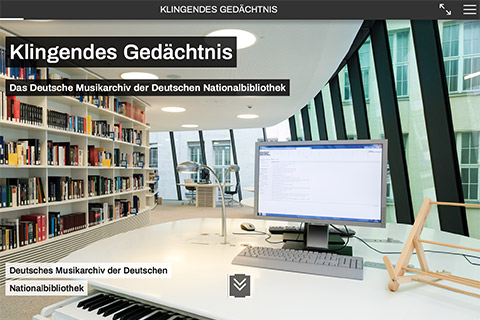
The German National Library’s German Music Archive is Germany’s central music bibliography information centre. We collect and archive audio recordings and sheet music published in Germany in order to preserve them permanently and make them available to users.
The virtual exhibition “Klingendes Gedächtnis” (Acoustic Memory) offers insights into the history and tasks of the German National Library’s German Music Archive. Join us in the stacks and see how all the different sound recordings are archived and stored. During our virtual tour, we will show you how and where you can work with our collection.
Along with the latest audio recordings and sheet music, we also collect historical sound recordings and their respective sound reproduction devices. From wax cylinder to piano roll, we have assembled a number of objects from the early days of the sound carrier industry that go right back to the beginnings of sound recording. We also have the historical sound reproduction devices on which they can be heard once again.
You can also press the audio button to have all the virtual exhibition’s texts read aloud.
Knowledge creates democracy. The library of St Paul’s Church, Frankfurt
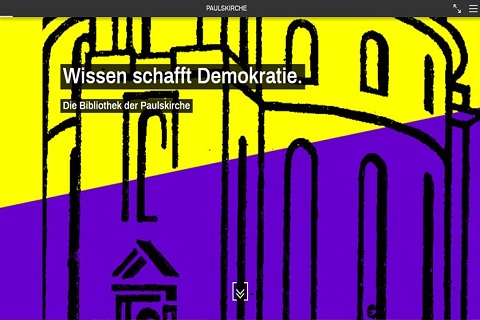
The German Museum of Books and Writing presents a virtual exhibition to mark the 175th anniversary of the Frankfurt Parliament which was held in St Paul’s Church in Frankfurt. The exhibition takes a unique look at Germany’s first parliament and why it failed. The Frankfurt Parliament of 1848-1849 was the first congress of democrats in Germany. This year’s anniversary exhibition explores the Library of the Frankfurt Parliament of 1848/49 (called “Reichsbibliothek“), which was brought into the collection of the German National Library in Leipzig in 1938. The parliamentary library was a reference library whose collection was intended to support the parliamentarians in their work to establish democracy in Germany. The fundamental principle was that participation and democracy are only possible when they are based on knowledge. And for the German National Library, that idea is as relevant as ever. As the saying goes: knowledge creates democracy.
Occupied space – billposting by German occupiers 1939–1945

National socialist Germany occupied most of Europe between 1939 and 1945. Posters from this time show the suffering this caused to millions of people very clearly: bills posted on walls, fences, advertising pillars or house walls are addressed at the population in the streets. The texts that are often shown in the languages of both the occupiers and the occupied call for certain behaviours, frequently combined with threats. The bills shown in the virtual exhibition are part of the German National Library’s special collection dedicated to World War II.
On the History of Newspaper Printing
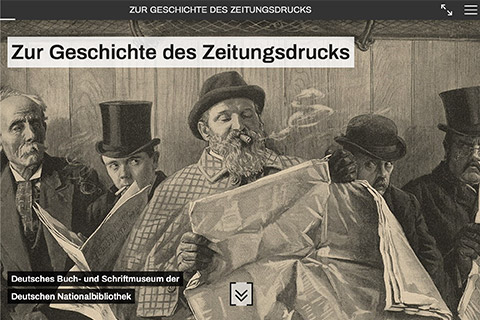
The virtual exhibition “On the History of Newspaper Printing” spans the period from the newspaper’s predecessors – the flyers of early modern times – to the digital methods used to produce the daily newspapers we read today. The online presentation makes full use of the German Museum of Books and Writing’s newspaper history collections. Gutenberg’s invention of movable type made it possible to publish large quantities of proclamations – albeit sporadically – in the form of broadsides. The expansion of the postal network created the conditions necessary for the regular distribution of news. As it developed, this daily mass medium became able to serve an ever-growing readership with a wide variety of interests. The virtual exhibition traces the historical development of newspaper printing and provides insights into technical innovations and the history of censorship.
Robert Hans Olschwanger – Caricaturist in Exile

The special exhibition is dedicated to the artwork of graphic designer and caricaturist Robert Hans Olschwanger (1905–1998). He started working for the Frankfurter Zeitung in the 1920s and remained there until 1935, when the National Socialists stripped him of his right to practise his profession. In 1939, he obtained a visa which allowed him to emigrate to Peru. From Lima, he provided commentaries on global political events for the most important Peruvian daily newspapers, earning himself a reputation as a caricaturist who wielded an acerbic pen.
Robert Hans Olschwanger's extensive estate has been held by the German Exile Archive 1933–1945 at the German National Library since 2021. It contains more than 1,100 drawings, caricatures and commercial graphics as well as personal documents and a ballad to German youth.
Rühr mich nicht an! – Zur Kulturgeschichte des Social Distancing
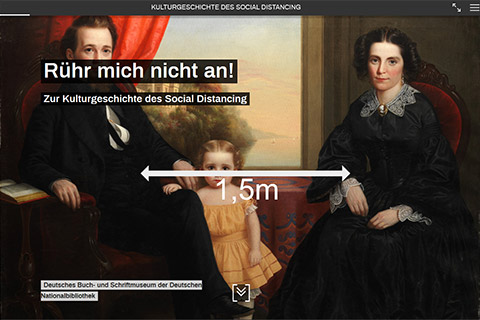
In 2020, “social distancing” was one of the central measures implemented worldwide to curb the spread of the COVID-19 pandemic. Everyone had to learn that the avoidance of physical closeness and gestures of greeting and farewell was an instrument that effectively prevented infection with the novel coronavirus. As a cultural technique, this kind of distancing is nothing new. There are numerous examples in art and literature that show how social relations throughout history have been shaped by distancing and keeping a distance. The virtual exhibition “Rühr mich nicht an!“ organised by the German Museum of Books and Writing in cooperation with the Deutsche Digitale Bibliothek (German Digital Library—DDB) is a collection of prominent examples of distancing.
Schmonzetten, Schmäh und Parodie (Melodrama, snide humour and parody)
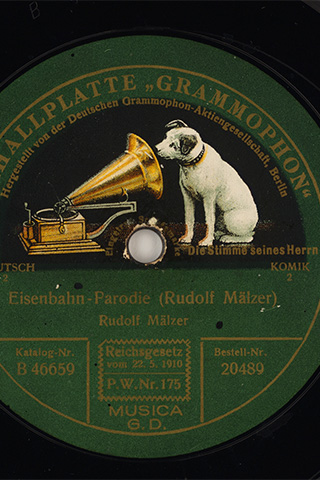
From the variety stage to the living room: Willy Rosen, Claire Waldoff, Otto Reutter, Max Pallenberg, Fritz Grünbaum and Paul Nikolaus were the great cabaret artists of the early 20th century. They discussed, caricatured and sang about people, everyday life, art and the world in their day, often with caustic humour. Thanks to phonograph cylinders and shellac records, their sketches, humorous dialect poems and parodies were soon heard in many households. Our virtual exhibition „Schmonzetten, Schmäh und Parodie“ (“Melodrama, snide humour and parody”) is an opportunity to listen to and smile wryly at these recordings.
The German Music Archive of the German National Library has a collection of historic cabaret and satire recordings dating from the 1900s to 1930s. We have digitised a selection of these for the virtual exhibition
Come and listen! Guaranteed to make you laugh!
… schreib mal wieder! (Write again!) The cultural history of letters
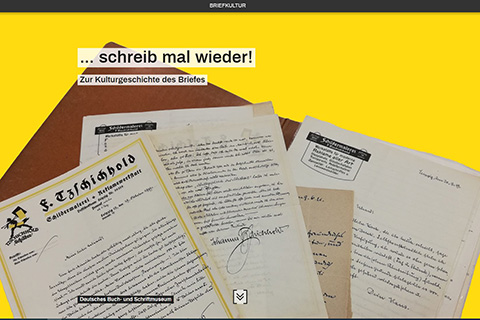
The virtual exhibition “...schreib mal wieder! (Write again!) The cultural history of letters” has five chapters and takes readers on a journey across several centuries of letter-writing history. Starting with the first written messages, via transport through messengers and later the postal service, all the way to the development of the letter we know today. How did people write letters 200 years ago? Did they always have envelopes? And what is a sound picture postcard? These and many other questions are addressed in the exhibition and presented visually, using a wide range of items from the collections of the German Museum of Books and Writing. In addition, the exhibition takes a look into the future – how are letters going to evolve further in the digital age?
Small. From the estate of typographer Jan Tschichold
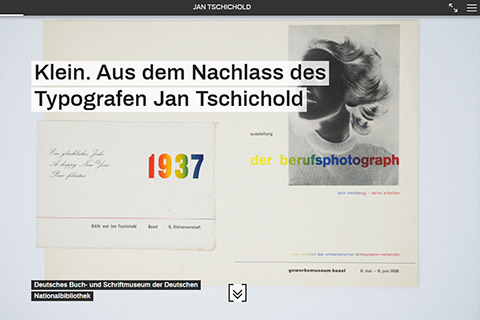
Although he was never a member of the Bauhaus movement himself, the Leipzig-born typographer and book designer Jan Tschichold (1902–1974) is regarded as one of the most important exponents of functional typography, also known as “New Typography”. His drafts are graphic design classics.
The virtual exhibition “Small. From the estate of typographer Jan Tschichold” presents small, everyday objects and unknown drafts from the typographer’s estate, including business cards, New Year’s greetings and labels for records. Jan Tschichold worked for numerous clients and designed many things that have remained largely unknown until now.
Visit the virtual exhibition and discover the everyday objects that are often quickly forgotten and much less likely to be preserved than the artist’s famous works.
The beauty of engraving and text

Otto Rohse, who would have celebrated his 100th birthday on 2 July 2025, was one of the 20th century's leading German book designers. His work came to the attention of a wider public from the 1960s on, mainly because of his stamp designs, which helped shape the Federal Republic's image at home and abroad for decades to come. With his privately operated Otto Rohse Press, he embodied the ideal of the artist who designs every element of the book himself – from typeface and graphics to paper, print and binding. Rohse applied the highest artistic standards to everything he did, be it high book art for small groups or commercial graphics for mass use.
This is us! 75 years of basic law. Publication history.
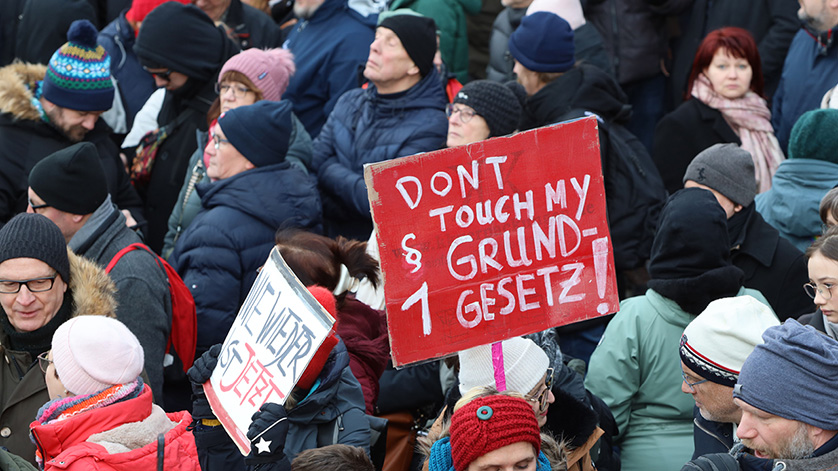 Photo: Dirk Knofe
Photo: Dirk Knofe
The Basic Law of the Federal Republic of Germany has been the foundation of German democracy for 75 years.
The virtual exhibition “This is us! 75 years of Basic Law. A publication history” is devoted to the basic law of our constitutional state, one key element of which is the protection of freedom of expression from extremist dissension.
Ulrich Becher - writer in exile
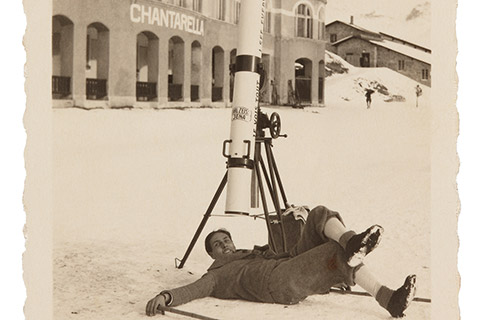 Photo: Swiss Literary Archives
Photo: Swiss Literary Archives
The special exhibition devoted to Ulrich Becher’s exile period takes visitors through the various stages of Becher’s exile, with particular attention to the opportunities for writers in exile, the importance of networks when on the run and in exile, and Becher’s remarkable friendship with George Grosz.
The exhibition is the result of a cooperative project realised by the German National Library’s German Exile Archive 1933–1945 and the Swiss National Library’s Swiss Literary Archives. Both archives house part of Ulrich Becher’s estate. It is only possible to gain a fully rounded impression of Ulrich Becher as a writer in exile by considering both partial estates together. (Photo: Swiss Literary Archives (SLA), Swiss National Library, Photography: probably Elise Becher, with kind permission of Martin Roda Becher)
Woher? Weshalb? Warum? Provenance stories from the German Museum of Books and Writing
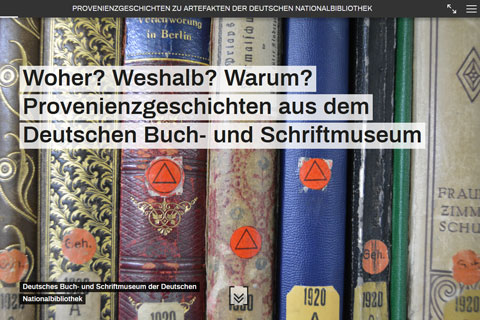
“Woher? Weshalb? Warum?“ (“Where from? What for? Why?”) is a virtual exhibition exploring the origins of the collection amassed by the German Museum of Books and Writing. It complements the publication “Tiefenbohrung. Eine andere Provenienzgeschichte” (“Deep Drilling. A Different Provenance Story”) and contains extracts from the object biographies narrated in the book. Presented in an entertaining digital format, it invites visitors to browse exciting stories from more than 140 years of collecting. The virtual exhibition can be accessed through the Deutsche Digitale Bibliothek (German Digital Library).
Last changes:
18.12.2025
Short-URL:
https://www.dnb.de/virtualexhibitions

